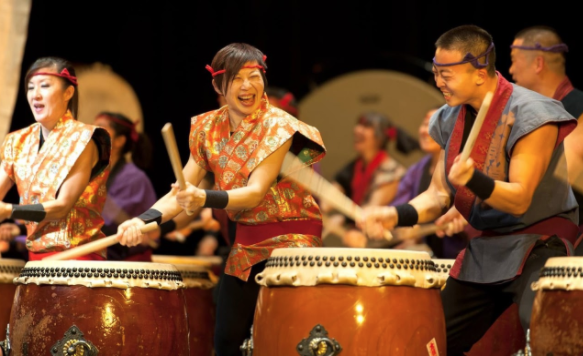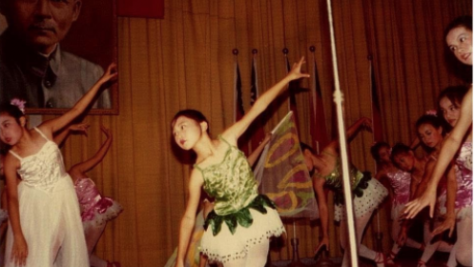
Chinese Teacher Ting-Chi Li (center) performs on the traditional Japanese percussion instrument, the Taiko. Li has been playing for around 20 years.
Ting-Chi Li expresses herself through Taiko
In her own words:
I grew up in Taiwan with four older sisters and one younger sister. We didn’t have a lot of resources or money; we were a very humble family who had just enough to go by. There weren’t a lot of toys or clothing, but we had bookshelves full of novels and story books.
Books were always there, so I became used to grabbing them and sitting next to the bookshelf. My mom would always ask me to go outside, but I just sat there reading.
I’m an introvert. And also, I’m a really shy person. But my mom is the opposite, so she thought I was really weird. She’s like, “Why are you like that?” She’s like, “Come on, talk to people, talk to our neighbours, talk to your uncles, aunties. Why are you- just utter a word.” She was really frustrated with me because I just didn’t know what to say. I felt awkward.
And she thought like, “Okay, maybe if I sent her to dance class, she would be, like, more outgoing.” That’s her thought. So, then she’s like, “Okay, yeah. Go take ballet lessons with your sisters.”

At that time, I’m not sure if it really helped me to become more outgoing or extroverted. That is who I am. An introvert.
However, it did give me the opportunity to realise how much I love dancing. I was not only good at it, but I felt really good while doing it.
Here in London, I still take lessons. I’m not involved in any sort of formal dance company because before moving to England, I hadn’t been dancing for a long time. Instead, my life revolved around playing Taiko.
I was living in Los Angeles when a friend invited me to a drum circle party. The backyard was filled with percussion from all over the world, including Indian drums and African djembe. The Japanese taiko was one of them.
The drummer handed me a flyer. “I’m offering lessons,” he said. I started learning with him, and I fell in love with it.
I was like, “Oh my God, this is such an amazing thing, I love it.” So, I started searching online like crazy. ‘Taiko’, ‘the Bay Area’, ‘San Francisco’, ‘California’. Any information I could get. At that point, Taiko in Northern California was just start[ing] to grow. There wasn’t that much information.
But in that year, I just saw, like, “Oh, there’s a Taiko conference in Los Angeles. Oh, interesting. Taiko conference? I’ve never heard of that, so let me register.” So, I registered.
I look at all the workshops. I don’t know any of these people. I don’t know any of them. I don’t know which one to choose. So, I just saw one master class with grandmaster Seiichi Tanaka. “Sounds good, two masters; I’m going to enroll in that class.”
So I enrolled in class and went to the Taiko conference. And I was like, “Oh my god, you can play Taiko like this? You can play and move? You can play a drum and move around a drum? Oh, that’s crazy. I love it!”
That same summer, there was a Taiko camp hosted in Northern Californian woods. Coincidentally, it happened to be taught by the same instructor at the conference: Tanaka Sensei.
All my energy and time was on Taiko; it became the center of my life.
— Chinese Teacher Ting-Chi Li
So, we were in the woods. I was walking around during a break, you know, enjoying the trees and everything. He saw me and he’s like, “Ting-Chi, Ting-Chi, come over here.” I’m like, “Okay, yes? What?” He’s like, “This is my business card. If you ever come to San Francisco, come to Taiko Dojo.” So I’m like, “Oh my God, the master wants me there. He remembers me.”
At that point in time, I was getting really tired of my job. I needed a change. Why not move to San Francisco?
I went and applied for my second master’s degree in Northern California, so I could attend grad school full time and also do Taiko.
I started as Taiko Dojo in San Francisco as a student, then a performing member, and finally, an instructor. I went to dojo three nights a week and every weekend. All my energy and time was on Taiko; it became the center of my life.
Taiko has helped me learn more about me as a learner, as a person and also how I deal with frustration and challenges.
Tanaka Sensei has a very traditional Japanese way of teaching. We have to follow certain hierarchical rules and etiquette, such as referring to mentors as senpai and mentees as kohai.
In addition, traditional Taiko is taught by spoken words, kuchi shoga, so one cannot rely on the music, as there is no music score. It was really challenging for me because the backbeat and the rhythm is not something my body goes with. My body always learned to naturally take the lead.
I was trained as a dancer, so, I physically am, it’s easy for me to adapt [to] the movement. For his style, his Taiko style, he has a lot of movement. He incorporates a lot of dance movement and then martial art movement. So that part was really easy for me to adapt.
So, I picked up the movement really quickly. I learned the rhythm by watching the movement. Now read the rhythm because I don’t know any other instrument. I’m not trained musically. So I learned this melody from watching arm movement, everything, I can do it, but now [came] the issues.
“I’m good at this,” I thought, “I’m good, come on. See, I’m better than your other students who have been studying with you for 5-10 years.” I was not necessarily that arrogant, but I felt that I was very confident.
But when it comes to rhythm, because I was not trained musically, my rhythm was off. My tempo was way faster. I mean, I was not even aware of that. So when people were trying to correct me, I’m like, “I don’t I didn’t get it.” I’m like, “What do you mean? What do you mean I’m off[beat]? How do I fix it?”
The struggle was frustrating, and it became even more puzzling because I was competitive. I was so good before. How could I become so bad now?
I just practiced, practiced, practiced and practiced. That’s my personality.
I just practiced, practiced, practiced and practiced. That’s my personality.
— Chinese Teacher Ting-Chi Li
Growing up in an Asian household and in Asian countries, it was easy for me to adapt to this mindset. If I want to learn something, I must be willing to make the effort. And since I wanted to play Taiko, the only way to do that is to practice.
Now, I’ve been playing Taiko for 20 years.
It’s because I can be myself. I don’t have to think. It’s me. It’s real me or a different side of me. I am a different person when I’m on stage, versus, you know, being with strangers. When I’m being with strangers, or if you put me on the stage to give a talk, you want me to express myself with words in public? I have trouble doing that.
But if you want to ask me to dance? To perform on stage? Oh, wow. It’s like, I would do it completely open […] crazy things I would do, like, completely be me.
Performance gives me an outlet to express myself without using words.

